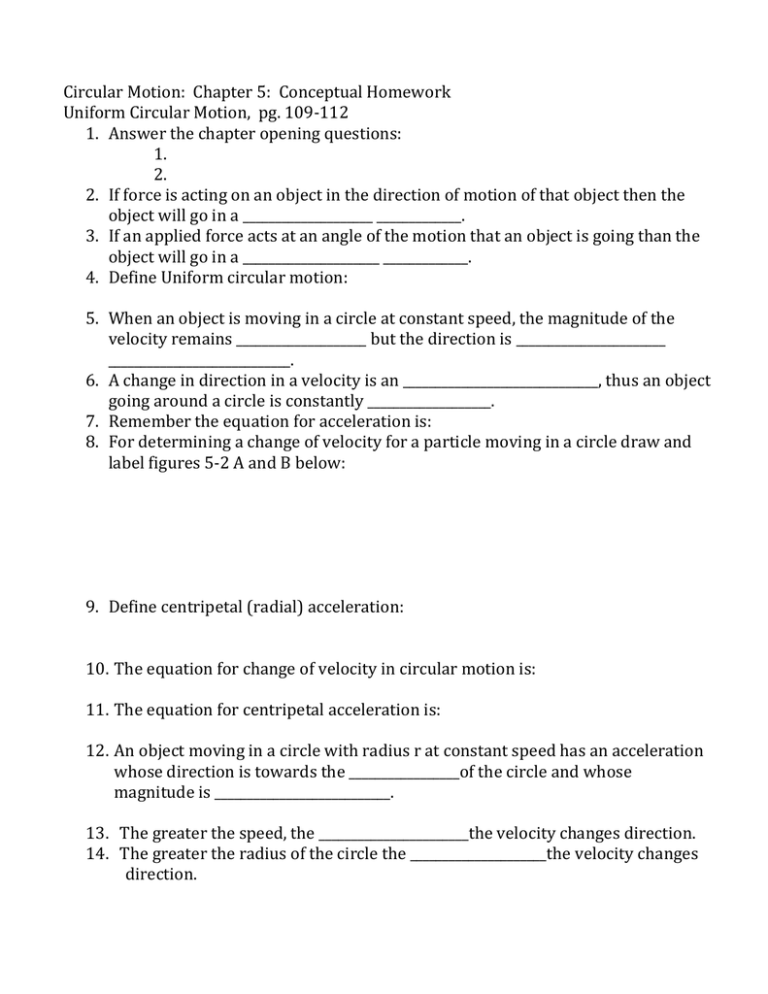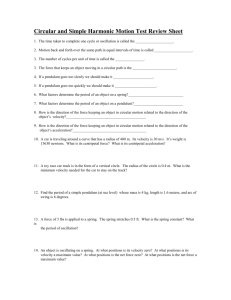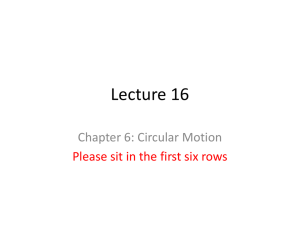Homework conceptual section 5-1 and 5-2
advertisement

Circular Motion: Chapter 5: Conceptual Homework Uniform Circular Motion, pg. 109-112 1. Answer the chapter opening questions: 1. 2. 2. If force is acting on an object in the direction of motion of that object then the object will go in a ____________________ _____________. 3. If an applied force acts at an angle of the motion that an object is going than the object will go in a _____________________ _____________. 4. Define Uniform circular motion: 5. When an object is moving in a circle at constant speed, the magnitude of the velocity remains ____________________ but the direction is _______________________ ____________________________. 6. A change in direction in a velocity is an ______________________________, thus an object going around a circle is constantly ___________________. 7. Remember the equation for acceleration is: 8. For determining a change of velocity for a particle moving in a circle draw and label figures 5-2 A and B below: 9. Define centripetal (radial) acceleration: 10. The equation for change of velocity in circular motion is: 11. The equation for centripetal acceleration is: 12. An object moving in a circle with radius r at constant speed has an acceleration whose direction is towards the _________________of the circle and whose magnitude is ___________________________. 13. The greater the speed, the _______________________the velocity changes direction. 14. The greater the radius of the circle the _____________________the velocity changes direction. 15. Velocity and acceleration vectors are ___________________________ to each other around the circular path. 16. What is frequency? 17. What is period? 18. How are frequency and period related? 19. In a circle with circumference of 2r, an object travels at constant speed and travels a distance of 2r in one time around the circle, which gives us the equation for velocity in the circle as: 20. Read Example 5-1 about the acceleration of a revolving ball. Read the approach, then try to solve the problem below: 21. Reflection: How did your solution compare to the book? Were you able to solve the problem correctly? What did you need to do differently? 22. Read example 5-2, Moon’s centripetal force. Think how you would solve the problem. Solve the problem below. 23. Reflection: How did your solution compare to the book? Were you able to solve the problem correctly? What did you need to do differently? Dynamics of Uniform Circular Motion: pg 112-114 1. An object that is moving in a circle must have a _________________ _____________________ acting on it—According to Newton’s _______Law. 2. The equation for the net forces on centripetal acceleration is: 3. Since acceleration is directed toward the center of the circle, the force also must always be _________________________________. 4. The net force must be constantly changing _______________________ to keep it directed toward the center of the circle. 5. Define centripetal force: 6. What is “centrifugal” force and why is it a misconception? 7. What would happen if centrifugal force were a true force to objects in circular motion? 8. Read example 5-3 and the approach, try the example here: 9. Read example 5-4, try this one on your own before you check your answer: 10. Write a summary of the four steps to problem solving uniform circular motion: Now try it on your own. Do problems #1, 7 and 13 in your text on a separate piece of paper.



